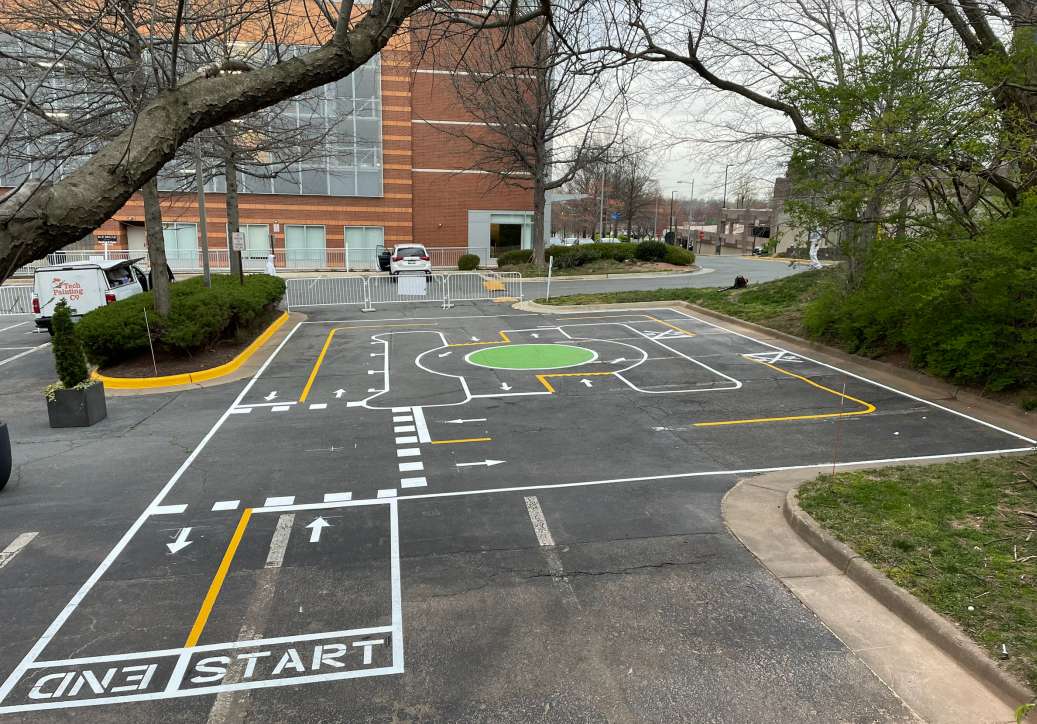
The Tysons Community Alliance (TCA) hopes to put the “play” in “play-cemaking” with a mini festival on Saturday (April 6) that will feature food, art and opinions about what might make the urban center tick.
Hosted by Celebrate Fairfax at The PARC at Tysons (8508 Leesburg Pike) from 10 a.m. to 1 p.m., the TCA Placemaking Fest is envisioned as both an example of how to distinguish Tysons and an occasion for community members to share their thoughts on future activities that could cement that identity.
The TCA will present proposed concepts at interactive stations, where attendees can give feedback while nursing an ice cream scoop from Tysons Creamery or bopping to music spun by DJ Cabezon.
“There’s going to be music, there’s going to be an interactive art piece. There’s going to be food for people and games,” TCA project manager Colleen Hawkinson, who organized the event, said. “We really want families and friends and everyone to come and really enjoy it and experience the activation and what placemaking can be.”
Feedback gathered at the event will inform a placemaking framework being developed by the TCA, a nonprofit community improvement organization tasked with promoting Tysons and guiding its evolution as Fairfax County’s aspiring downtown.
When it was created in October 2022, the TCA identified “placemaking” as a focus of its mission, along with communications, transportation and support for businesses. Acknowledging that the concept can seem intangible, Hawkinson says it can refer to anything that encourages people to interact and spend time in a particular space.
Examples range from physical design elements, such as a mural or splash pad, to events like farmers’ markets and the block parties held at The PARC, which was converted from a defunct Container Store into an event space in 2021.
“It’s about building up these places that then help support and create the sense of community,” Hawkinson said.
To showcase the concept, the TCA Placemaking Fest will have the aforementioned live music by DJ Cabezon, a “collaborative art experience” with local artist Michael Pacheco, photo booths, and food trucks from Tysons Creamery, Colonial Kettle Corn, El Chef Latino and Fine Dining to Go.
There will also be a “mobility maze” where kids can ride scooters through a mini street network with lanes, signs, sidewalks and even railroad crossings. Essentially a traffic garden with a different name, the maze was provided by Tech Painting Company and the transportation engineering firm Gorove Slade.
Admission to the event is free, though attendees are encouraged to register in advance.
The TCA anticipates finalizing its placemaking framework in May, allowing it to start implementing the recommendations as soon as this summer, according to Hawkinson.
“The TCA will certainly move forward on some things,” she said. “Some things might need assistance from the county…and there are areas where our private sector friends and partners may come in and help out, and that kind of gets around the essence of placemaking…all these different entities working toward a common goal.”
With the help of local developers and property owners, the Tysons Community Alliance is on a mission to beautify the green spaces found where many of the area’s major roads intersect.
The first site targeted is the southwest quadrant of the Route 7 (Leesburg Pike) and Route 123 (Chain Bridge Road) interchange, where the Vienna-based company Tyson’s Tree Service began clearing overgrowth, invasive plants and dead trees on Jan. 2.
Led by the affordable housing firm SCG Development, which is headquartered nearby at 8245 Boone Blvd, the clean-up effort will set the stage for the approximately 2 acres of land to be replanted with native species and new landscaping — a process that Tysons officials hope to repeat at other locations.
“I would almost call this a pilot,” TCA spokesperson Karyn Le Blanc said. “…We would want to take a look at this, analyze it and then, see where we can replicate it in other areas or take the best parts of what’s worked on this and use this in other areas as well.”
The idea for the Tysons beautification project came from SCG Development President Steve Wilson. After 35 years of traveling the local roadways as a Northern Virginia resident, Wilson noticed the accompanying open spaces and landscaping had gotten unkempt, and in December 2022, he “just decided something needed to be done about it,” he told FFXnow.
Tysons has about 140 acres of green space that go unmaintained, mostly around its six major interchanges where routes 7 and 123, the Dulles Toll Road and the Capital Beltway (I-495) meet. That amounts to 5% of the 2,743-acre area designated as Fairfax County’s urban center, per SCG.
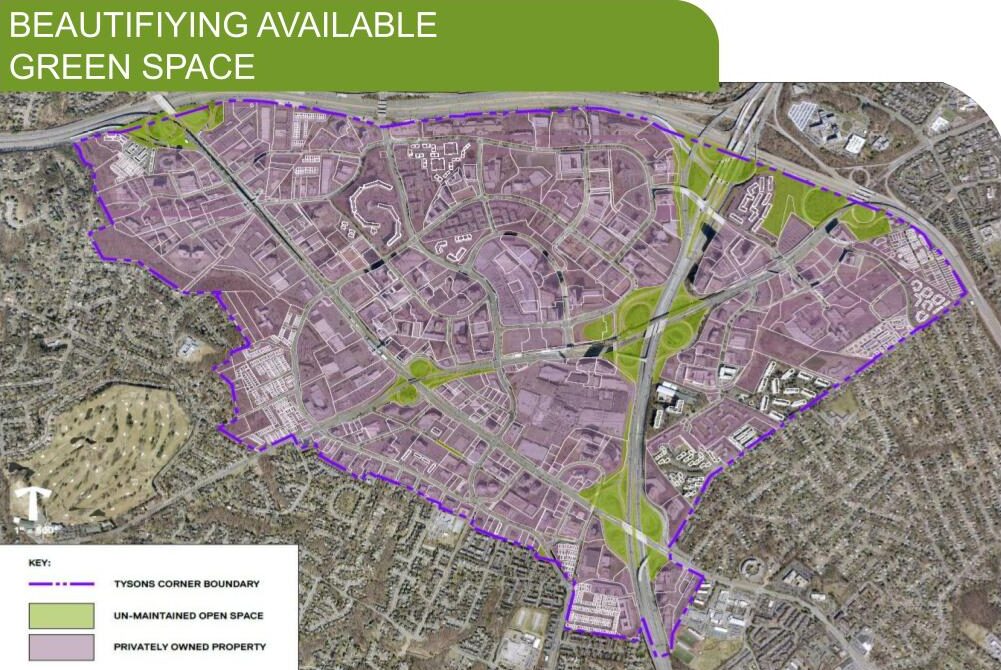
Arguing that cleaning up these areas would reduce safety concerns, encourage more pedestrian traffic and improve property values, the developer soon met with Providence District Supervisor Dalia Palchik, who represents most of Tysons, and offered to test its concept by sponsoring the Leesburg Pike and Chain Bridge Road interchange.
Once studied as a possible park, the site is “highly visible” and “perhaps the worst in terms of being overgrown,” Wilson says. He also highlighted its proximity to the Fairfax County Economic Development Authority, whose headquarters overlooks the interchange. Read More
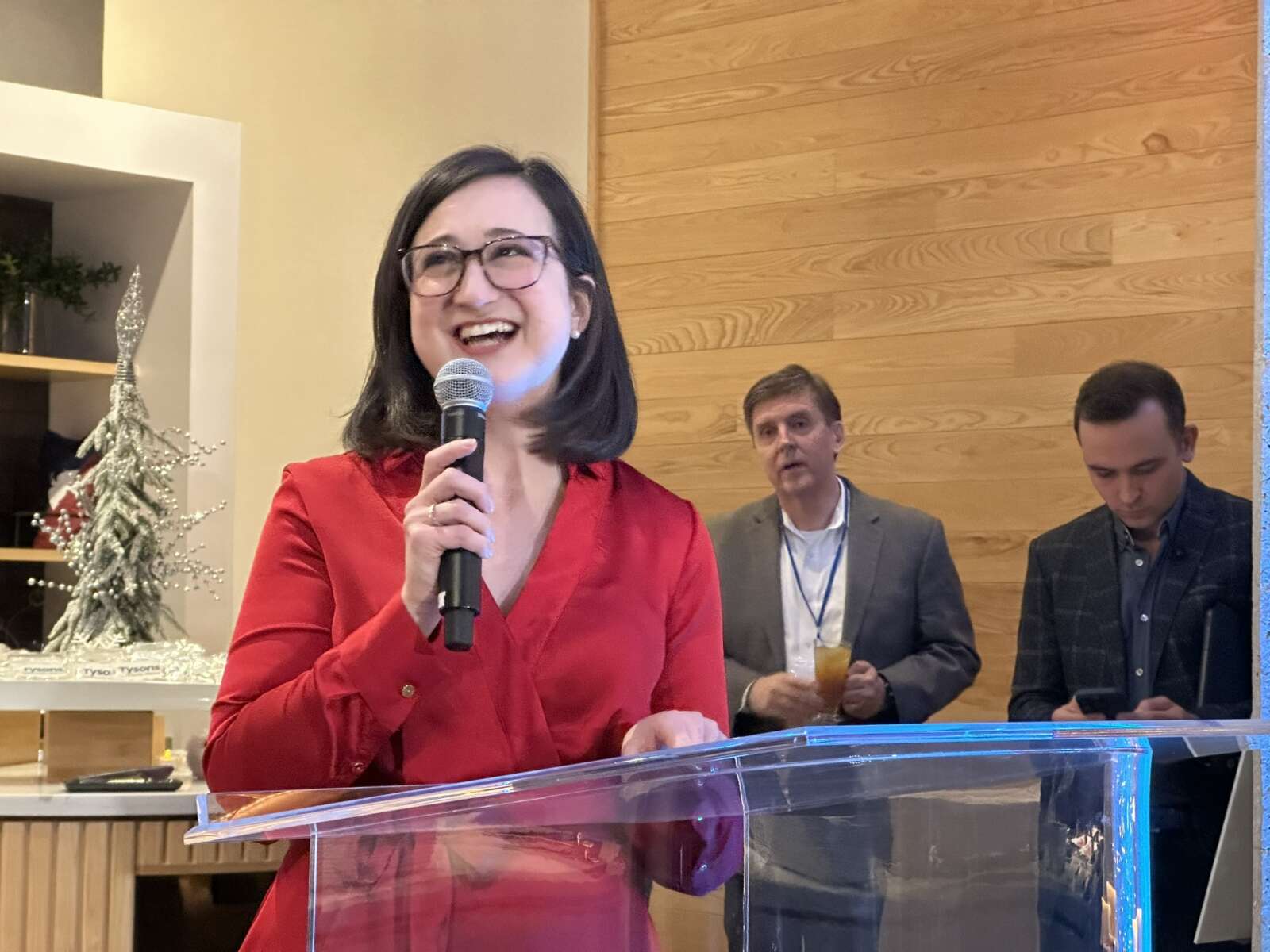
When Fairfax County adopted its Tysons Comprehensive Plan in 2010, it wasn’t quite creating a community from scratch. After all, the area had history: first as home of the Manahoac tribe, then as rural farmland and finally, as a suburban crossroads known for malls and offices.
However, transforming car-centric sprawl into a place people not only want to go to, to take a phrase from the Washington Post, but also stay in remains a formidable challenge.
Tasked with ensuring that challenge is surmounted, the Tysons Community Alliance (TCA) released a strategic plan on Thursday (Dec. 14) that reaffirms the priorities laid out in the comprehensive plan and the recently established booster organization’s mission.
Celebrating the organization’s first year of existence at The Watermark Hotel in Capital One Center, TCA leaders noted that the importance of connections between people and places emerged as a predominant theme of the strategic plan, which is titled “Connecting Tysons.”
“So much of the vision of the Tysons comp plan and, in fact, the potential for success of Tysons depends on public sector, private sector, civic sector working together,” TCA CEO Katie Cristol said. “So, to literally be able to bring those groups of people together across the table from one another to build this plan made a huge impression on me and, I think, made the plan a lot stronger.”
Work on the strategic plan began this spring and involved a committee of residents, business leaders, county officials and other community members with varied experiences of Tysons. They formed “task groups” that focused on different sectors: office and the workforce, resident life and housing, retail and entertainment, hospitality, transportation and community amenities.
The resulting document highlights five overarching themes that will guide efforts to implement the county’s vision of Tysons as a “dynamic, 24/7 urban center”:
- Cultivate and promote identity. Strategies include using marketing to define Tysons as a whole and its individual neighborhoods.
- Energize place. Create attractive public spaces where people can gather and feel connected to their community.
- Build connections and enhance mobility. Improve the accessibility of Tysons for all modes of transportation, particularly walking, bicycling and transit.
- Build a livable and inclusive community. The plan calls for affordable and attainable housing, enhanced parks and other community facilities, and broad public outreach.
- Foster a vital economy. Key goals include attracting and retaining businesses that serve offices and residents, enhancing the “workforce experience,” increasing capacity for large meetings or community gatherings, and diversifying the retail and hotel markets.
The plan’s development was informed by data from a Tysons market study released on Aug. 4 as well as a community survey that drew 831 responses.
The study found a need for more housing in Tysons, examined how the economy is recovering from the pandemic, and identified gaps in the area’s transportation facilities. Cristol says the findings provided more specific evidence to back up experiences that committee members were sharing anecdotally. Read More
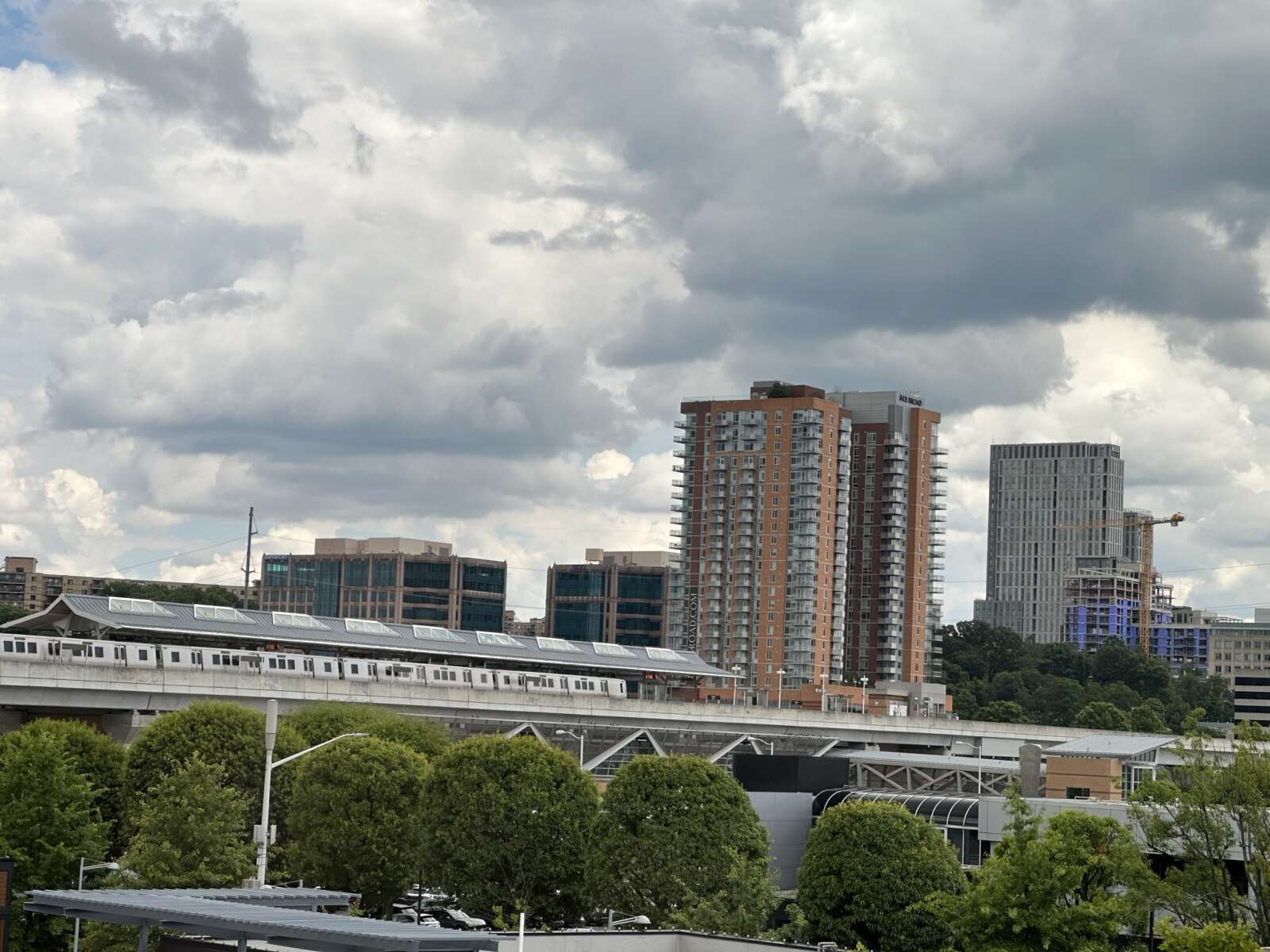
If Fairfax County were to get a casino, state Sen. Dave Marsden would prefer to see it in Tysons, not Reston, as has reportedly been proposed.
The prospect of a casino has drawn strong pushback from both residents and some elected officials, but Marsden argues that the county needs to consider all options to diversify its commercial tax base, as the office market continues to lag in the pandemic’s wake.
While Tysons has gotten more residents over the past decade, the area’s generally commercial makeup and four Metro stations would make it “the ideal place” for an entertainment district that could include a casino, Marsden says.
“That’s becoming Fairfax County’s downtown, and we want to locate it on the Silver Line because that’s what the Silver Line was built for,” the senator told FFXnow. “…It wasn’t just to bring in commuters from Loudoun County or to get people to the airport. It was designed also to allow for higher density development: high-rise apartments and office buildings and what have you.”
Marsden, who represents parts of Burke, Centreville and Annandale in the 37th Senate District, and Del. Wren Williams (R-9) filed identical bills in January that would’ve added Fairfax County to the small list of Virginia localities authorized to consider hosting a casino.
Though the legislation was quickly withdrawn, the subject reemerged late last month when Patch reported that the developer Comstock hopes to build a casino near the Wiehle-Reston East Metro station, where it has been constructing the massive Reston Station neighborhood.
A member of the Senate finance committee, Marsden confirmed to FFXnow that he met with Comstock twice — once while drafting his original bill and once since then. He says he otherwise hasn’t been approached by anyone about a casino in Tysons or anywhere else in Fairfax County.
Comstock doesn’t have any properties in Tysons right now, but it pitched a redevelopment of the Koons auto dealerships at 2000 and 2050 Chain Bridge Road last year as part of the county’s site-specific plan amendment (SSPA) process. The nomination didn’t advance after county staff determined a comprehensive plan change isn’t necessary to allow mixed-use development on the site.
The developer — which donated $10,000 to Marsden’s reelection campaign on June 22, per the Virginia Public Access Project — didn’t return multiple requests for comment.
Marsden says he’s “certainly very strongly looking at” re-introducing the casino bill in the 2024 General Assembly session if he wins the election for the newly created 35th District, though it likely won’t be identical to the one introduced this year.
“I do want to talk to some of our elected folks in Fairfax County to see how they would want the bill structured, to take a look at it,” he said.
He stresses that the goal of the bill isn’t to impose a casino on the county, but rather, to give the county an option that’s currently off limits.
As a Dillon Rule state, Virginia localities only have the powers explicitly granted to them by the General Assembly, an approach that Fairfax County officials argue limits their ability to do everything from exploring different revenue sources to lowering speed limits on dangerous roads.
If Marsden’s bill gets adopted by the General Assembly, the county would be required to hold a referendum asking voters whether a casino should be permitted.
“[Comstock’s] idea for an entertainment district, I think, is a reasonable idea that the county needs to consider,” Marsden said. “Ultimately speaking, I will not make the decision as to whether Fairfax County has a casino or where it’s located, but merely give them the opportunity to make that decision for themselves.” Read More
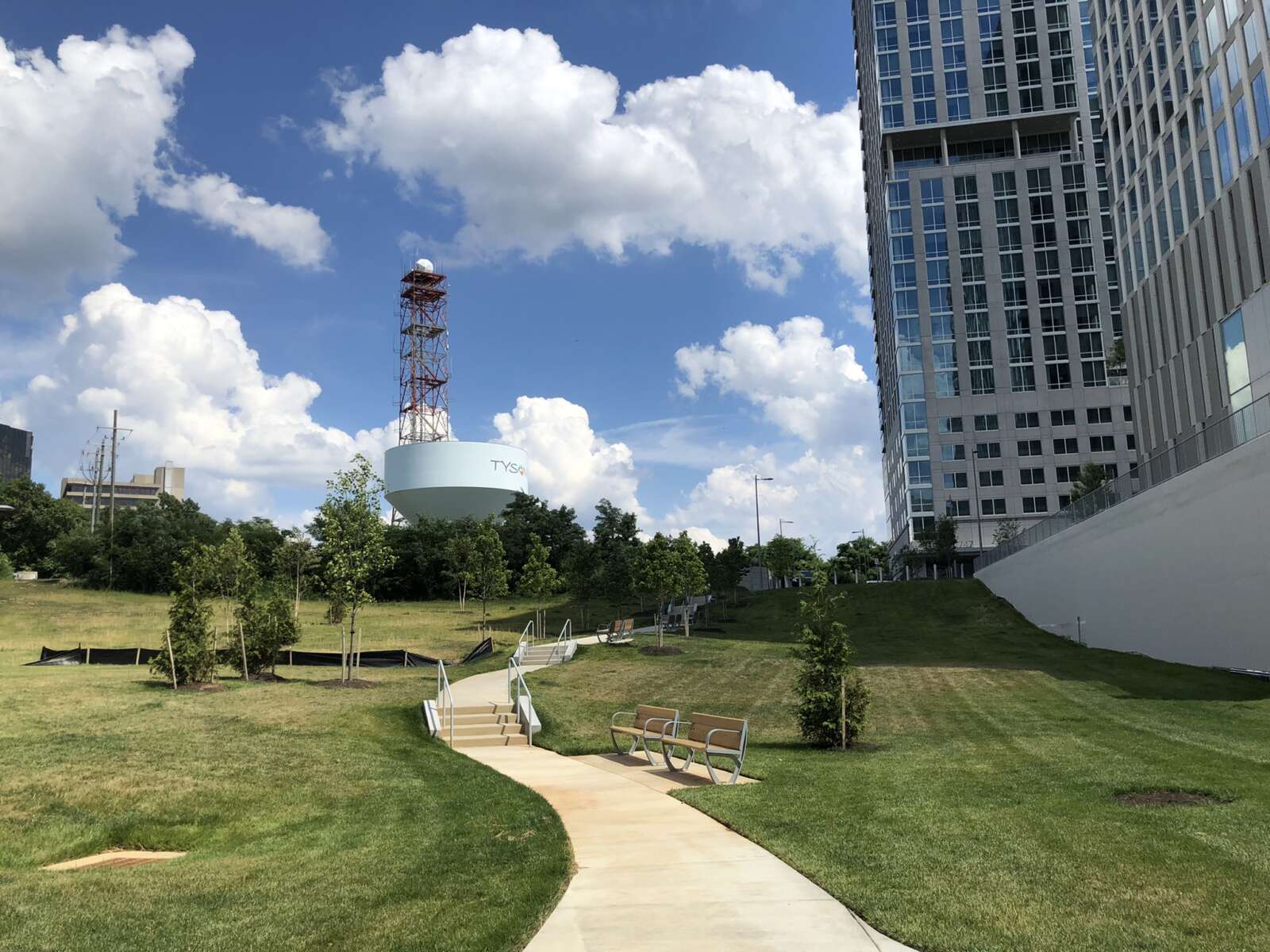
Tysons has seen some promising developments in its transportation network in recent years, but many obstacles remain to achieving Fairfax County’s vision of a truly accessible downtown, a market study released earlier this month suggests.
Commissioned by the Tysons Community Alliance, the 2023 Tysons Market Study characterizes the 2,100-acre urban center as “somewhat walkable” — meaning at least some errands can be accomplished on foot — based on its official average Walk Score of 57.
Calculated based on population density, the distance to amenities, block lengths and other factors, the walk score ticked up from the 54 that Tysons got in 2020 when the COVID-19 pandemic began. The area is more walkable than Reston, which has a score of 40, but it falls short of more urban areas in the region, including Crystal City in Arlington (71) and downtown D.C. (98), according to the study.
The most walkable properties are in central Tysons, particularly around the Greensboro Metro station, which is also where multifamily housing has concentrated, TCA CEO Katie Cristol notes.
“That increase in the walk score is a real validation…of how environmentally sustainable, how much better in terms of quality of life the new residential development has been in Tysons,” Cristol said. “It is in the right places, it is in places that are walkable, so more Tysonians live [in places] walkable to Metro and other amenities and can easily reach the necessities of their lives on foot than could before.”
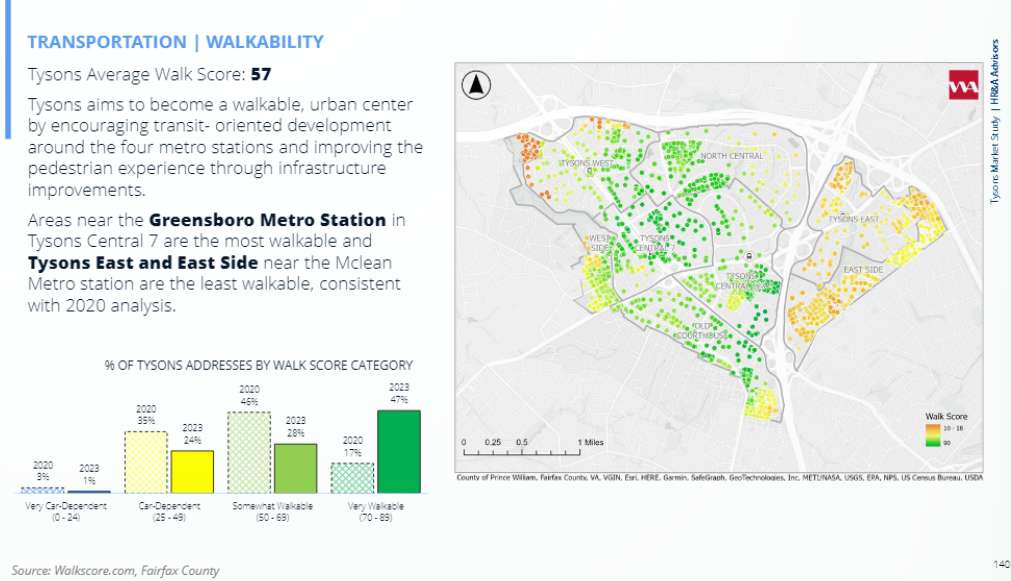
However, properties east of Route 123 — where most for-sale and single-family units are located — tend to be more car-dependent, per the study. Based on 2021 Census data, the percentage of car-free households in Tysons has jumped up to 5.1% — an over 50% increase from 2019 — but 47% of households still own two vehicles.
In addition, the TCA identified 4.6 miles of missing sidewalks, and most of the 24 miles of sidewalk that do exist are just 4 feet wide, which “is not ideal for a growing area seeking to promote walking,” the study says.
The improved Walk Score was also tempered by a lowered Bike Score, which dipped from 49 in 2020 to 43 this year. Categorized as “somewhat bikeable” with “minimal” infrastructure, Tysons trails Reston, which stayed flat at 54 over that time frame. Read More
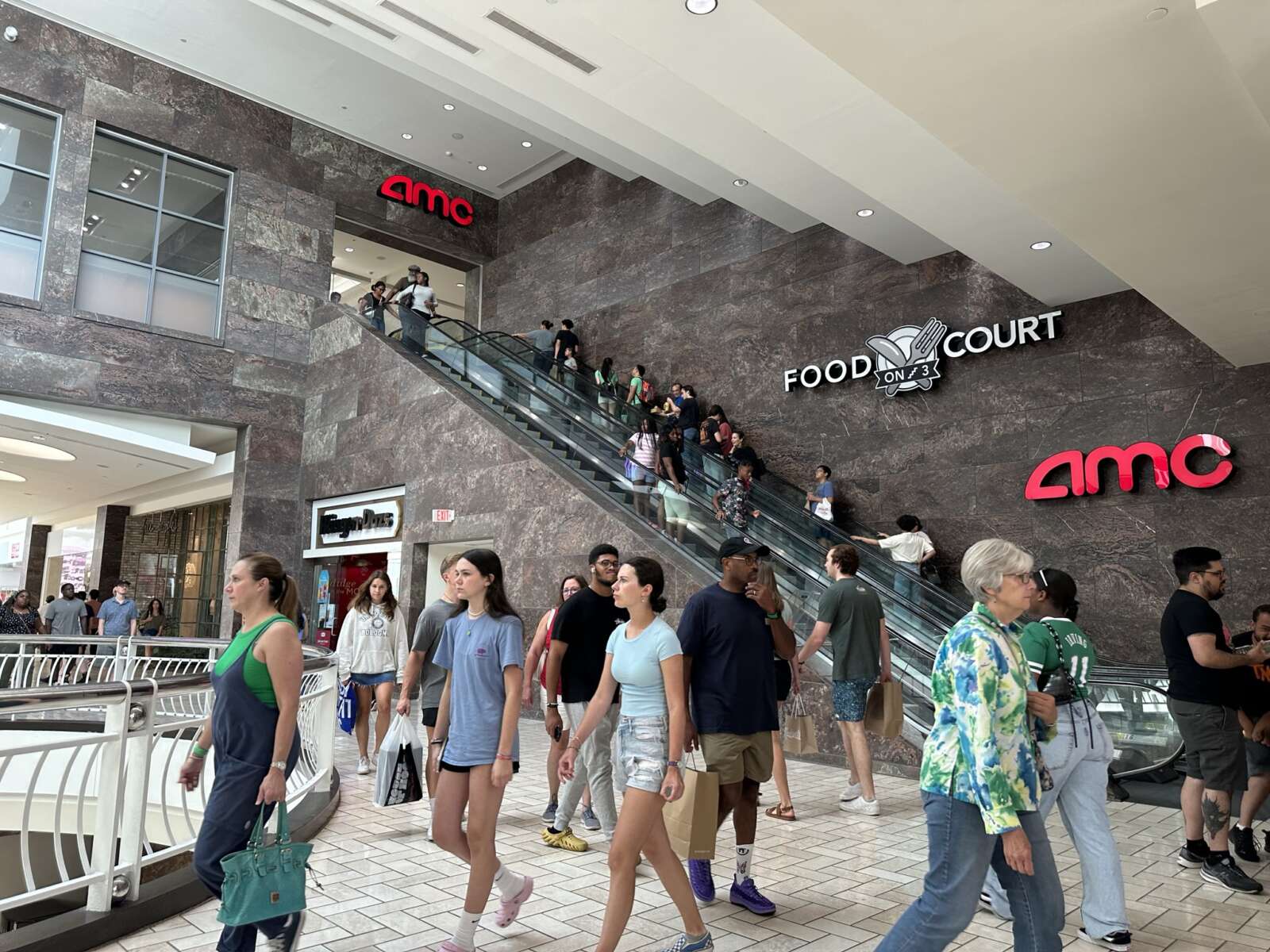
Tysons is increasingly becoming a place where people live, but a recent market study from the Tysons Community Alliance raised some questions about its future as a place where people work.
Released on Aug. 4, the study paints divergent pictures of the two commercial sectors that have defined Tysons since the 1960s — office and retail — as they navigate a post-pandemic world of remote work and online shopping.
While retail visits in Tysons have returned to 92% of the 2019 average, foot traffic at office buildings is at 77% of pre-pandemic levels, according to the study, which was conducted by consultants HR&A, Toole Design and Wells & Associates.
That’s still better than D.C., where office visitation is at just 70% of pre-pandemic levels, but the study found that Tysons is seeing “somewhat slower employment growth” both in general and among office users than Fairfax County and the overall D.C. region — a lag expected to continue through 2028.
“Tysons grew more slowly than surrounding Fairfax County and the D.C. [metropolitan area] in the last three years and is projected to continue growing more slowly in the next five years,” a workforce growth analysis summary said, identifying health care as the industry projected to add the most jobs in Tysons over the next five years.
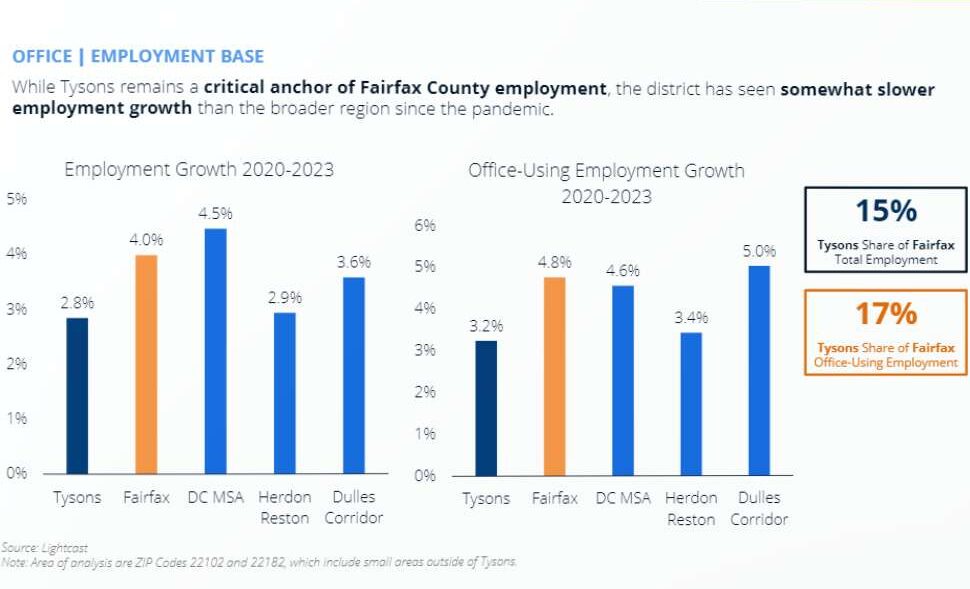
Even though over 85% of Tysons workers are in industries that traditionally use offices, led by 47,100 workers in the broad category of “professional services,” the area’s office vacancy rate has climbed from 14.8% in 2019 to 20% so far this year.
That exceeds the county’s 16.7% vacancy rate, which is a 10-year high, Fairfax County Economic Development Authority leaders told the Board of Supervisors at an economic advisory committee meeting on July 18.
Constituting 5.6 million of the area’s 27.6 million square feet of office space, the vacancies have particularly affected lower class, older offices built before 1990, suggesting a “preference for newer and nicer properties,” the study report says.
Despite the “historically high” vacancy rates, average rents have grown 24% since 2015 to match the D.C. area’s average of $39 per square foot, driven in part by the $65-per-square-foot asking price at the Tysons Central office building that was completed last year.
Tysons also has an additional 1.9 million square feet of office under construction or planned, though the majority of upcoming development is residential.
“If vacancies remain high, future deliveries could result in stagnant rents and continued high vacancy,” the report says. “For developers to fill pipeline office space, office-using jobs in Tysons need to grow at 1.4 times the projected growth of 3,300 jobs between 2023 and 2033.” Read More
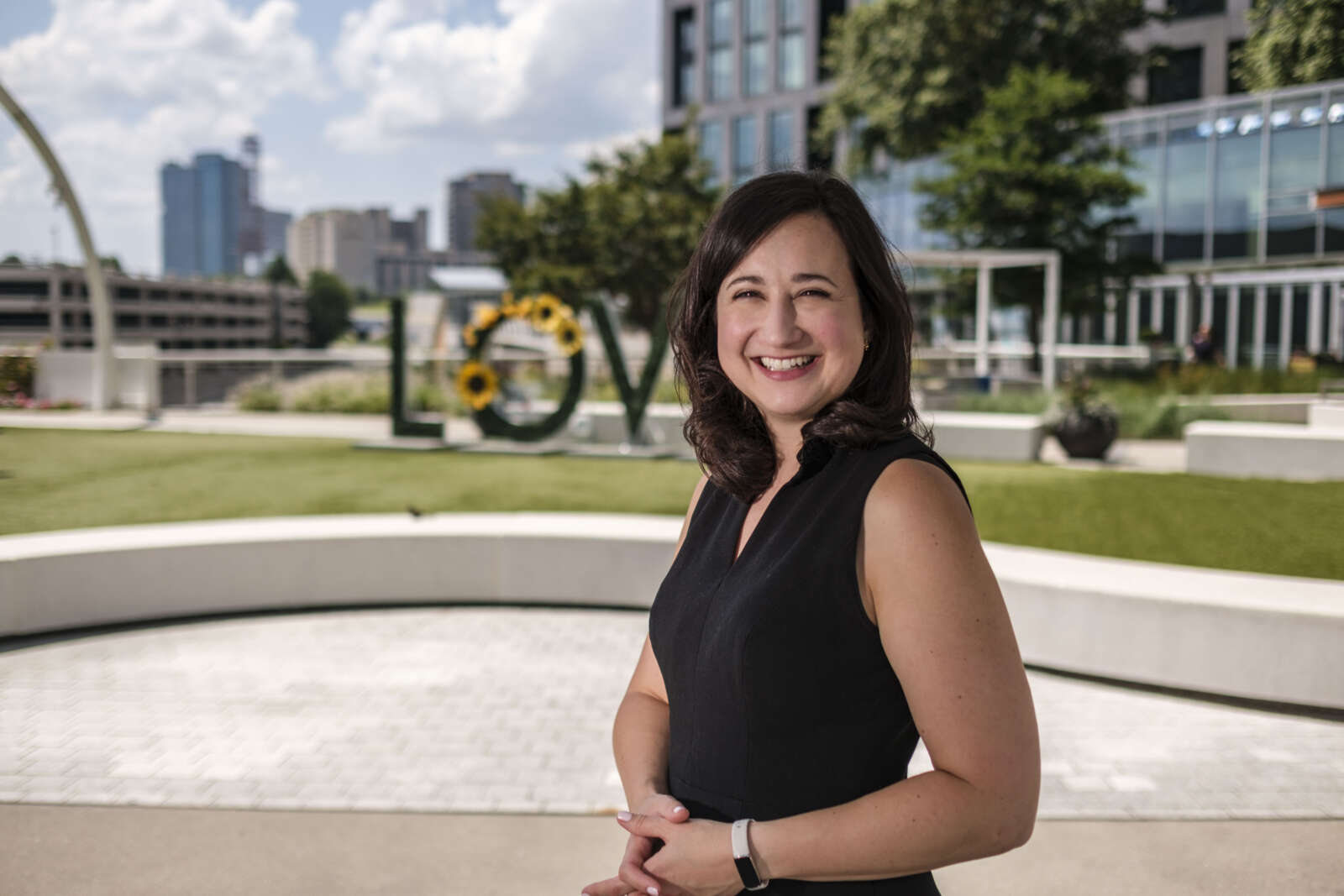
Katie Cristol wants to help Tysons become what the community imagines it could be.
Since taking over as the Tysons Community Alliance’s first permanent CEO on July 5, Cristol has been busy overseeing the creation of a Tysons strategic plan to identify priorities and needs for the 2,100-acre area envisioned by Fairfax County as an urban downtown where “people live, work and play.”
While a final report isn’t expected until November, the word “connected” keeps popping up in Cristol’s mind when she considers what it’ll take to turn Tysons into the vibrant, accessible and inclusive community that the TCA is tasked with manifesting and marketing.
“There are so many assets in Tysons, and I think one of our biggest opportunities is to create a sense of place,” Cristol told FFXnow in an interview last month. “It’s not just disconnected neighborhoods, but it is a downtown, and so, that absolutely requires physical connectivity…It also requires a sort of emotional connectivity, people really seeing themselves as being part of a broader community.”
From identifying gaps in the sidewalk network to promoting local events, building connections is essentially the core mission of the TCA, a community improvement organization that’s funded by but operates independently from the county.
Tysons booster by day, Arlingtonian by night
On a more personal level for Cristol, building connections also means networking, as she adjusts to a new working environment after serving as chair of the Arlington County Board for almost eight years.
She knows some Tysons residents may be wary of her ties to Arlington — and her continued residency there, which was acknowledged in a May 2 message saying she’ll “keep the title I’ve always valued most: Arlingtonian.”
However, after getting involved in the Tysons Partnership, the TCA’s predecessor, Cristol says she was drawn to the opportunity to continue working on issues like housing, transit and land use in an organization intended to bridge divides between the public and private sectors and the community.
“I believe in the region and I think that we are all interconnected,” Cristol said. “In many ways, I am going to look like a lot of people in Tysons, who spend their day there, working, contributing to the sort of overall return of employment…enjoying the coffee shops and the diners, and really thinking a lot about the space around me, even though I may sleep somewhere else in the region at night.”
Lessons from one of the defining initiatives of Cristol’s tenure in Arlington — the contentious Missing Middle zoning overhaul — could carry over to Tysons, even if the goal of eliminating single-family-only zoning isn’t applicable to an area where 82% of the housing is multifamily, per a market study released last week.
Like Arlington, though, Tysons is grappling with an insufficient supply of housing for its growing population and ever-rising real estate costs that could keep out low-income households and even the middle-class, white-collar workers sought by many employers, Cristol observed. Read More
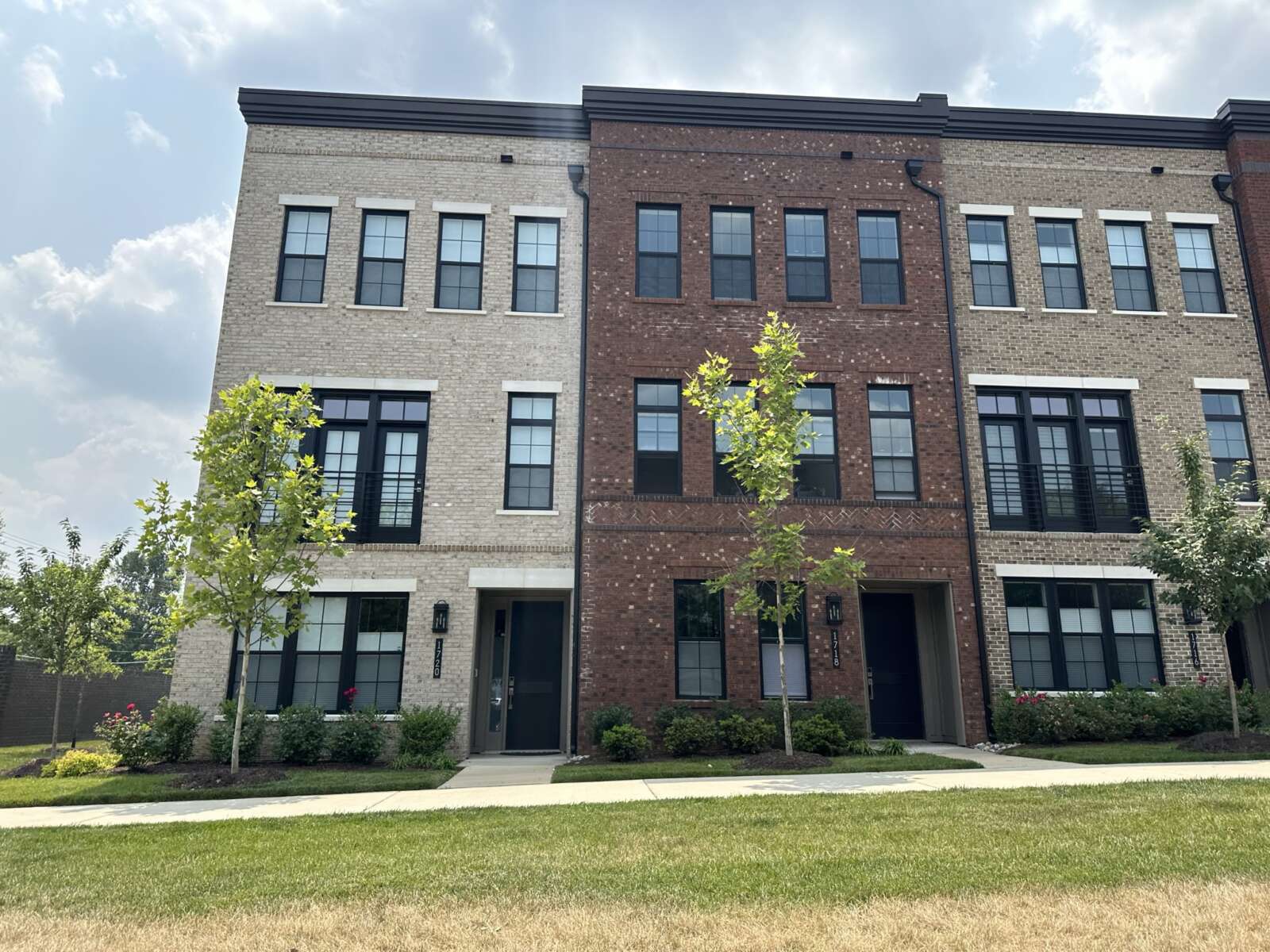
Tysons is going to need more housing.
Home to 17,000 people in 2010, the urban center saw its population grow to 29,620 people by 2021, according to a market study released Friday (Aug. 4) by the Tysons Community Alliance. Fairfax County staff reported earlier this year that there are now 30,124 residents.
Much of that influx came just in the past five years. Tysons added 13,000 households at a growth rate of 19% from 2018 to 2021 — tripling the 6% seen from 2015 to 2018, the market study found.
Its residential growth has easily exceeded that of Fairfax County as a whole (4% from 2018-2021) as well as the overall D.C. region (7% over that time period).
“Tysons is no longer just a place to shop and go to work,” said Providence District Supervisor Dalia Palchik, who represents most of Tysons. “The addition of Metro and now the completion of the Silver Line, investment in parks and public amenities, as well as the construction of bike trails, is creating connections within Tysons, to the region and beyond. People recognize Tysons as the type of community that they want to call home.”
While the county’s population has started to stagnate, Tysons is projected to reach more than 42,000 residents by 2030, though that pace would still fall short of the county’s goal of 100,000 residents by 2050.
To accommodate that growth, the area will need to add 4,400 more housing units, including an additional 1,900 affordable units, by 2032, the report estimates.
Tysons has made progress on building up its housing stock, which totals 8,600 units with 1,200 coming online since 2020 — a 16% increase. Another 1,600 units are under construction, and 624 have been approved but are still in planning, including about 516 units in the all-affordable Dominion Square West project.
Of the roughly 2,500 existing affordable units, 1,800 are “naturally occurring” because their market rate is affordable to households earning up to 80% of the area median income (AMI), which is $152,000 for a household of four people in the D.C. area.
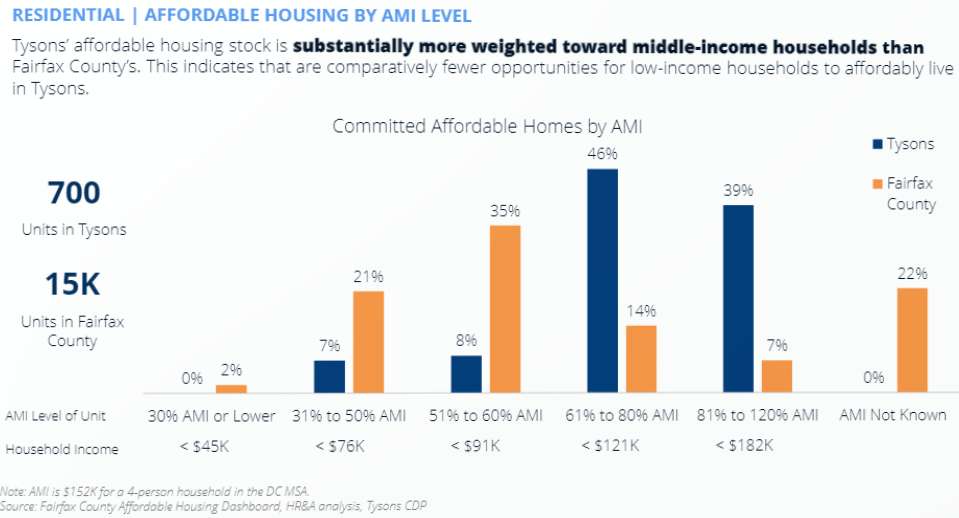
However, the vast majority of the 700 committed affordable housing units in Tysons is aimed at people making 60% or more of the AMI. Only 7% are available to people earning under $76,000 a year, and there are no units affordable to people making under $45,000. Read More
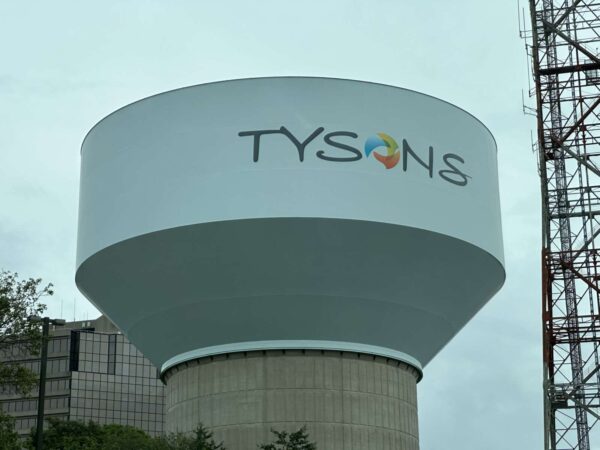
Fairfax County formalized its partnership with the Tysons Community Alliance earlier this week with a new agreement outlining the community improvement organization’s mission and structure.
Under the memorandum of understanding (MOU) approved by the Fairfax County Board of Supervisors on Tuesday (July 11), the TCA will turn to the county as a primary funding source going forward, even though it will operate independently as a nonprofit.
Tasked with promoting and advocating for Tysons as a community, the alliance will request funding through the county’s annual budget process, but the county has no obligation to fulfill the requests.
The group will also seek supplemental support from grants and “alternative revenue streams,” according to the agreement.
The unique financing model will require the TCA “to show our continued value” not only to Tysons, but also the county as a whole, CEO Katie Cristol told FFXnow in a recent interview. She assumed her position as the organization’s first permanent CEO on July 5.
“There are a lot of competing interests and needs throughout the county,” Cristol said. “…In literal dollars and cents terms, it’s a reinvestment back in Tysons so Tysons can keep delivering even more revenue for the good of the county, but it also, we hope, is going to generate some of these lessons learned that others will benefit from.”
Established last fall with $2.5 million in county funding, the TCA is responsible for implementing the county’s vision for Tysons as a downtown community where people live and work, not just a collection of offices and malls.
As outlined in the MOU, the group’s priorities will be communications and marketing, placemaking, research and business support, and transportation and mobility, including support for infrastructure improvements.
Some of that work is already underway, from community events to an ongoing strategic planning effort. Later this month, the TCA is expected to release an economic market study with data that could help it make the case that Tysons is a worthy investment for the county.
At a Board of Supervisors economic initiatives committee meeting last month, TCA Board of Directors Chair Josh White reported that Tysons brings in 8% of the county’s tax revenue.
“Can we take a small, small share of that and reinvest it back into the Tysons to support that overall growth?” Cristol said. “So, that was part of the idea, and the [TCA] governance is built around really giving government a strong voice.”
Cristol says the local government’s closer involvement separates TCA from similar nonprofit organizations that are typically supported by property or business owners, such Arlington’s business improvement districts.
In addition to potentially providing funding and having representatives on the TCA’s board of directors, the county will require annual reports from the alliance and collaborate on initiatives like public space enhancements, according to Providence District Supervisor Dalia Palchik, who represents much of Tysons.
Hunter Mill District Supervisor Walter Alcorn, whose district includes a western portion of Tysons, said he had hoped to see the TCA integrated with the existing Tysons Transportation Service District when it comes to funding road, sidewalk and other transportation projects.
“There’s still some work to be done to integrate those two concurrent activities,” he said at the board meeting.
The service district, which is funded by an annual tax on property owners, could complement the TCA’s funding for those projects, but the money won’t necessarily go directly to the alliance, according to Cristol.
Scott Sizer, a division manager in the county’s Department of Economic Initiatives, said the MOU was “written broadly to accommodate any future changes.”
“We hope it is a pilot that will be successful and will lead to other pilots in the county, but there is always a possibility to amend and to terminate,” Palchik said. “An MOU is a legal document, but I think it’s important that we be able to monitor [the TCA’s activities] and continue to ensure and hopefully see success.”
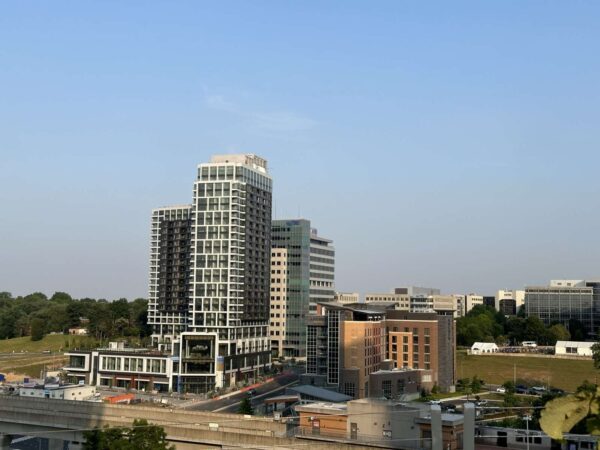
After introducing itself earlier this year with a website update and some cherry blossom-related events, the Tysons Community Alliance is now digging into the area’s strengths, needs and what needs to be done to set it up for future success.
Picking up where the now-defunct Tysons Partnership left off, the nonprofit community improvement organization launched a strategic planning effort for Tysons this week by convening a series of work groups that will focus on different topics, such as residential development, transportation and parks.
The strategic plan will serve as an update on the current state of Tysons and a guide to implementing Fairfax County’s Tysons Comprehensive Plan, TCA Board of Directors Chair Josh White told the Board of Supervisors at an economic initiatives committee meeting on June 13.
“One of the key purposes of the alliance is to help catalyze the continuing transformation of Tysons into a walkable, urban center and community,” White said. “…It is our intent to facilitate a community engagement process with a lens focused on diversity, inclusion, equity, and sustainability, which will chart a future direction for Tysons and help shape an action agenda.”
As part of the planning process, the TCA is conducting a conditions assessment and market study that will provide data on economic trends and gaps to support the future strategic plan as well as a new Tysons database.
Acting TCA CEO Richard Bradley — who will soon give way to the first permanent CEO, Katie Cristol — described the database as a more comprehensive version of the Tysons Tracker that the county launched in 2021, sharing information about all things Tysons, from population data to office usage.
Underway since April, the market study is slated to be finished around mid-July, per the presentation. But statistics shared by TCA leaders reinforced the oft-repeated refrain that Tysons is the county’s “economic engine,” while also exposing potential challenges to its ambitions.
Despite encompassing just 1% of the county’s total land area, Tysons accounts for 17% of its jobs, 10% of all retail revenue and 8% of tax revenues, White touted.
As reported to the Fairfax County Planning Commission in January, about 30,124 people now live in Tysons — a 96% increase from 2010, when the comprehensive plan was adopted. Like the county as a whole, the area has a “minority-majority” population, and while 29% of residents earn salaries of $200,000 or more, 38% have incomes of $100,000 or under — a larger percentage than in the overall county.
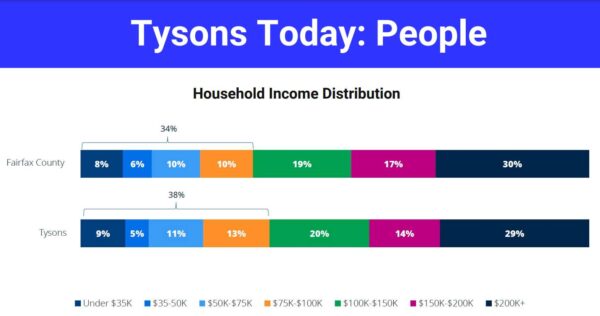
Some supervisors expressed surprise at those numbers, noting that affordable housing will be critical for maintaining the area’s “economic diversity.”
“I think we all hear Tysons or we hear McLean or we hear Oakton or we hear Falls Church or Alexandria, and we have these preconceived notions of who lives there and what does the community look like and what do the businesses look like,” Providence District Supervisor Dalia Palchik said. Read More

